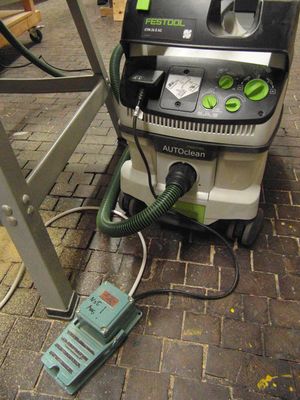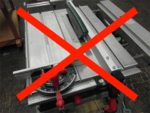Table Saw Introduction: Difference between revisions
From CoMakingSpace Wiki
m (→Dangers) |
(→Safety: turned into table; removed Bosch-specific "tighten all screws" & added "use dust extractor & blade guard whenever possible" for Elektra Beckum PK 255) |
||
| Line 4: | Line 4: | ||
== Safety == | == Safety == | ||
[[PPE|Personal protection]]: [[File:Protection - goggles.svg|50px]] [[File:Protection - hearing.svg|50px]] | |||
A [[Dust Masks|dust mask]] may also be necessary depending on the material you are cutting! | |||
* your | * [[gloves]]: make an informed decision | ||
** some sources say you should wear them to protect yourself against splinters which could surprise you and make your hand flinch in a dangerous position | |||
** others prohibit the use of gloves, fearing your entire hand could be dragged into the blade if one gets caught | |||
{| class="wikitable" | |||
|- | |||
! Dangers !! Precautions | |||
|- | |||
| sharp and rotating exposed blade, with chances of flesh wounds and missing limbs | |||
* will keep spinning for a bit after turning the power off! | |||
|| | |||
* your hands need to stay well clear (at least a hand's width) of the blade at all times | |||
** use a [[Push Sticks|push stick]] if you have something small to cut! | |||
* do not use the table saw when you are alone in the Space, you might need another Maker to call help in case of an accident | |||
* height of the blade: make an informed decision | * height of the blade: make an informed decision | ||
** high blade: cuts "down", not pushing against you - makes the saw easier to use and leads to less of a difference between cut distances on top and bottom BUT it exposes a lot of the dangerous blade | ** high blade: cuts "down", not pushing against you - makes the saw easier to use and leads to less of a difference between cut distances on top and bottom BUT it exposes a lot of the dangerous blade | ||
** low blade: lower risk of serious injury (could cut into your finger, not as easily ''trough'' it) but you have to push the workpiece harder | ** low blade: lower risk of serious injury (could cut into your finger, not as easily ''trough'' it) but you have to push the workpiece harder | ||
* use the top blade guard whenever it is not hindering your cut - it should be fixed so its bottom edge is horizontal | |||
* | |- | ||
| kickback - if the workpiece is pressed against the blade's side, it can be thrown towards the operator! | |||
* check out [https://youtu.be/u7sRrC2Jpp4?t=150 this video on YouTube] to see what that looks like | |||
|| | |||
[[File:Two table saw fences.png|thumb|150px|right|DO NOT use both fences at once!]] | |||
* never use both fences at once (option: fence + stop block which ends before the blade begins) | |||
* never remove the splitter and check that it is in line with the saw blade | |||
* make sure the parallel fence is in fact parallel | |||
* do not cut several pieces on top of each other! | |||
* use a shorter parallel fence when cutting solid wood ''(Massivholz)'' - that way, there is room for tensions to be released after the cut (second half of the blade should stand "free")<sup> [https://www.youtube.com/watch?v=NhnIqY3Fqqg&t=1m35s]</sup> | |||
* stand on the side where you can support the main part of your workpiece (usually the left) | * stand on the side where you can support the main part of your workpiece (usually the left) | ||
* give the saw time to start up before touching the blade with your workpiece! | * give the saw time to start up before touching the blade with your workpiece! | ||
|- | |||
* | | sawdust and small splinters can fly towards the operator || | ||
* wear [[goggles]] | |||
* use the [[Dust Extractor|dust extractor]] and - whenever possible - the top blade guard (sucks up dust as well!) | |||
* wear a [[Dust Masks|dust mask]] depending on the material you are cutting | |||
|} | |||
== Practical Demonstration == | == Practical Demonstration == | ||
Revision as of 16:12, 26 September 2019
This is the content required for an introduction to our table saw - reading this does NOT replace the mandatory session with a tutor! It will make it a lot quicker though ;-)
Let's begin! First off, make sure you have read the machine's manual.
Safety
A dust mask may also be necessary depending on the material you are cutting!
- gloves: make an informed decision
- some sources say you should wear them to protect yourself against splinters which could surprise you and make your hand flinch in a dangerous position
- others prohibit the use of gloves, fearing your entire hand could be dragged into the blade if one gets caught
| Dangers | Precautions |
|---|---|
sharp and rotating exposed blade, with chances of flesh wounds and missing limbs
|
|
kickback - if the workpiece is pressed against the blade's side, it can be thrown towards the operator!
|
|
| sawdust and small splinters can fly towards the operator |
|
Practical Demonstration

you should power the saw via foot switch and shop vac so that dust extraction starts automatically and everything is easily turned off
- parallel fence: three options depending on the desired distance
- foot switch as the preferred "off" option
- practice cut with miter fence & parallel fence


